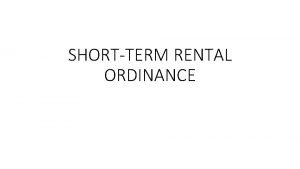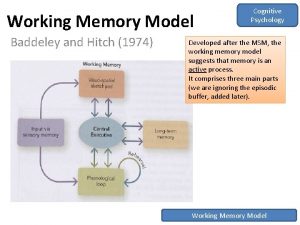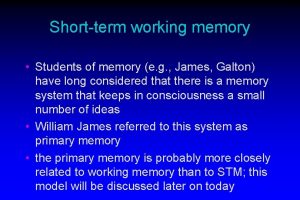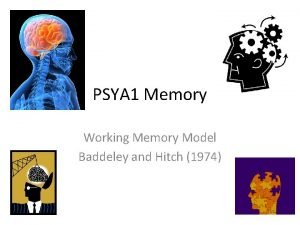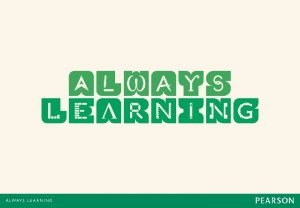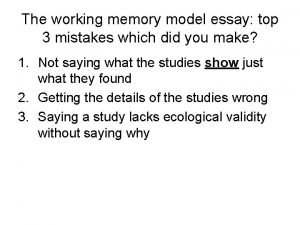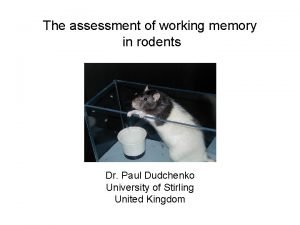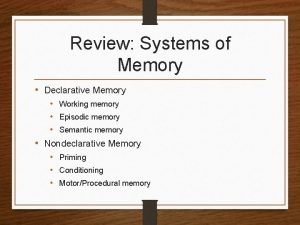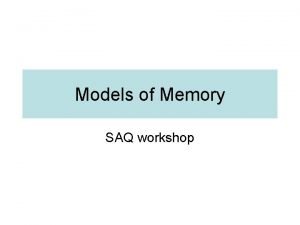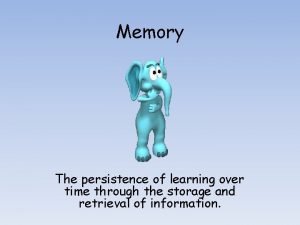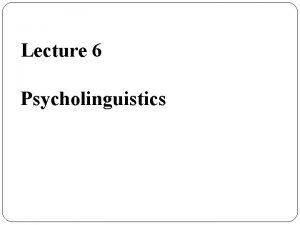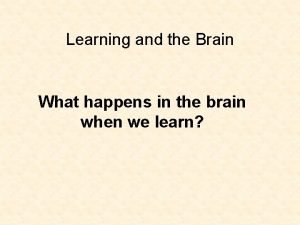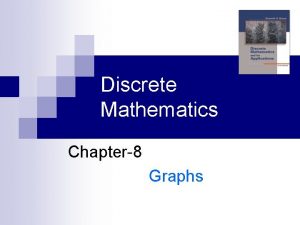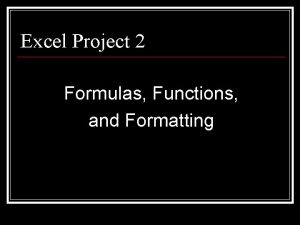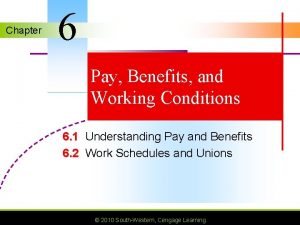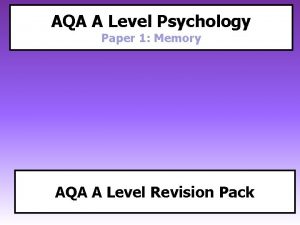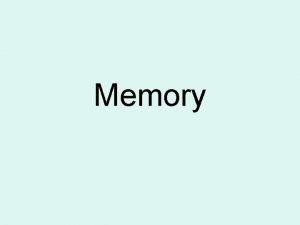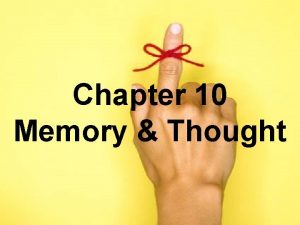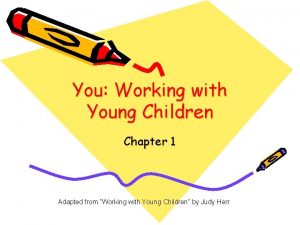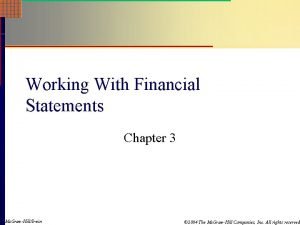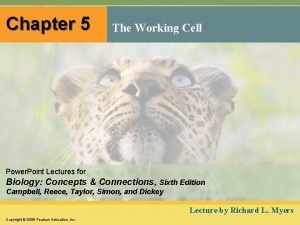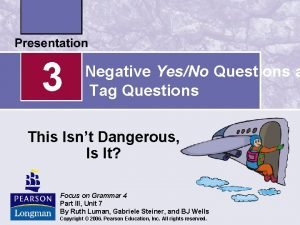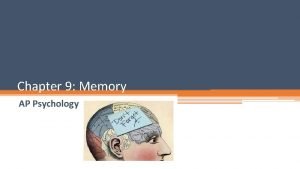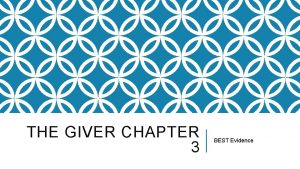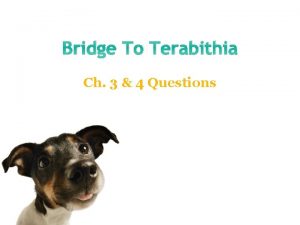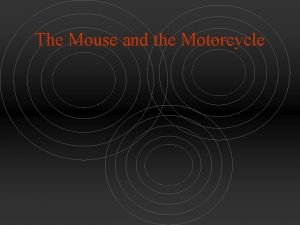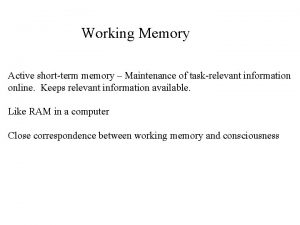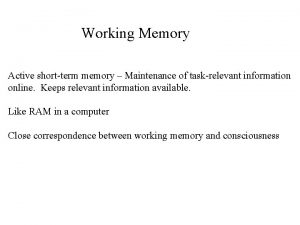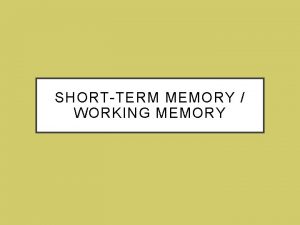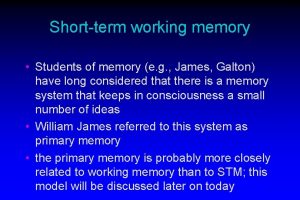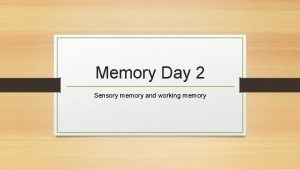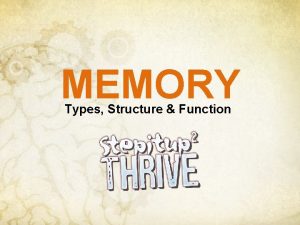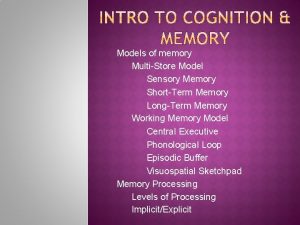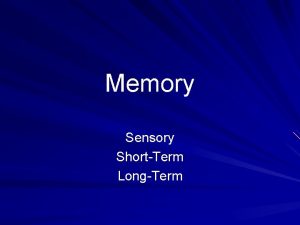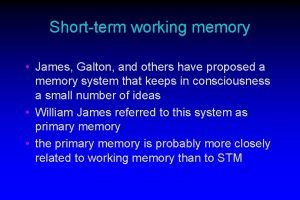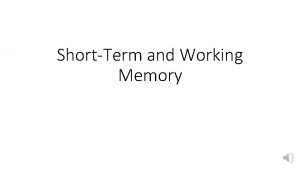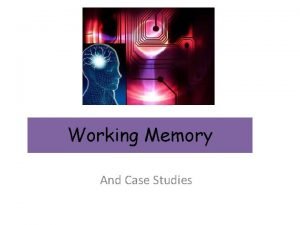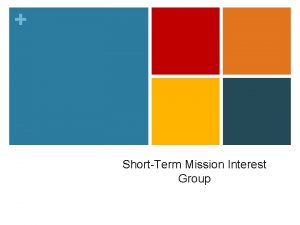Chapter 5 ShortTerm and Working Memory Some Questions




















































- Slides: 52

Chapter 5 Short-Term and Working Memory

Some Questions to Consider • Why can we remember a telephone number long enough to place a call, but then we forget it almost immediately? • How is memory involved in processes such as doing a math problem? • Do we use the same memory system to remember things we have seen and things we have heard? • Is memorization an important skill today? Why or why not?

What Is Memory? • Memory: processes involved in retaining, retrieving, and using information about stimuli, images, events, ideas, and skills after the original information is no longer present • Memory is active any time; some past experience has an impact on how you think or behave now or in the future

Modal Model of Memory • Atkinson and Shiffrin (1968) • Three different types of memory: • Sensory Memory – Initial stage that holds all incoming information for seconds or fractions of a second • Short-term Memory – Holds five to seven items for about 15 to 20 seconds. • Long-term Memory – Can hold a large amount of information for years or even decades

Modal Model of Memory

Modal Model of Memory • Control processes: Active processes that can be done by the person • Rehearsal • Strategies used to make a stimulus more memorable • Strategies of attention that help you focus on specific stimuli


Modal Model of Memory: Sensory Memory • Sensory Memory: The retention, for brief periods of time, of the effects of sensory stimulation. • Information decays very quickly • Iconic Memory • Persistence of vision: retention of the perception of light • Sparkler’s trail of light • Frames in film (a movie is composed of still frames) • Echoic Memory • Persistence of sound • Brief lapse in understanding what someone just said.







Modal Model of Memory: Sensory Memory • Holds large amount of information for a short period of time • Collects information • Holds information for initial processing • Experiments show that after delay and distraction recalling decreases rapidly.

Strategies of transferring info from STM to LTM • Practice makes perfect! • Repeat!. . . • You can re-read and re-verbalize the information over and over, or use some smart strategies • • Mnemonics Drawing: Visual clue Mind palace (filing system, data structure) Chunking (grouping)

Mnemonics • Example: how to remember the names of all five Great Lakes? • Superior, Michigan, Huron, Erie, Ontario • Super man helps every one (SMHEO)

Mnemonics • Another way: HOMES • Huron, Ontario, Michigan, Erie, Superior

Mnemonics • How to remember the names of the first 8 US presidents? • Will a jolly man make a jolly visitor? • George Washington • John Quincy Adams • Thomas Jefferson • James Madison • James Monroe • John Quincy Adams • Andrew Jackson • Martin Van Buren

Mnemonics • Can you remember the order of all eight planets in our solar systems? • Mercury, Venus, Earth, Mars, Jupiter, Saturn, Uranus, Neptune • My Very Educated Mother Just Sent Us Nowhere

Mnemonics • Ungraded discussion: Do you have some useful mnemonics that you want to share with your classmates and me? • Now you can use your laptop or phone to Google.

Drawing • Jeffrey Wammes’s experiment • After viewing the item pops up on the screen, the subjects were told to draw or write down the item. • Delay and distraction: they were told to do unrelated tasks and resume later to recall the items. • The drawing group outperformed the writing group. • Implications: When you do rehearsal or take notes, use graphical illustration!

Drawing • Example: try to write down and memorize these relationships: • Home background includes SES, father’s job, father’s education. Math, science, and language test scores indicate academic achievement. Net worth, income, and job satisfaction indicate career success. Home background influences school achievement, and this influences career success. • Draw it! Notes: This model above was developed a few decades ago and thus family background includes father only, but not mother.

Mind palace • https: //www. youtube. com/watch? v=3 vlp. QHJ 09 do • A fancy name of data structure or filing system • When you have a piece of information in your STM, identify its category and decide ”where” to put it. • I have my own mind palace: My website: http: //www. creative-wisdom. com

Modal Model of Memory: Short-Term Memory • Classical Experiment: Measuring the duration of short-term memory • Read three letters, then a number • Distraction: Begin counting numbers backwards • Delay: After a set time, recall three letters • After three seconds of counting, participants performed at 80% • After 18 seconds of counting, participants performed at 10% • Interference Theory vs. Decay Theory

Modal Model of Memory: Short-Term Memory

Modal Model of Memory: Short-Term Memory • Proactive interference: Occurs when information learned previously interferes with learning new information • Example: Your native language may make it more difficult to learn and remember a new foreign language • Retroactive interference: Occurs when new learning interferes with remembering old learning • Example: After you get a new telephone number and use it for a while, you may have difficulty remembering your old phone number

My experience • Usually in a five-week summer class my students can retain more information and perform better in the exam (And I got better end-of-course evaluation). • My theory: • In a summer course we meet three to four days a week. When I lecture new concepts on Tuesday, students still remember the previous related concepts that I taught on Monday. There is no delay causing memory gap. • In a 5 -week summer course most students take one to two classes only. They are fully occupied because they have to do the reading and assignments every day. No other interference or distraction affects their learning. • How about making all classes like summer classes?

Assignment • Format a small group of 3 -5 to discuss the following: • Some schools use a super-short semester system: Students are allowed to take one 4 -week class only before taking another 4 -week class. The argument is: without proactive or retroactive interference students can learn better by focusing on one subject matter at one time. • A theological seminary disallows students to take New Testament Greek and Old Testament Hebrews in the same semester. The argument is the same. • Do these schools correctly apply cognitive psychology into their pedagogy? Can this strategy lead to better learning outcomes? • Post 0. 5 -1. 5 pages on Canvas.

Modal Model of Memory: Short-Term Memory • Capacity of short-term memory • Digit span: how many digits a person can remember • Typical result: 5 -8 items • Change detection - Luck and Vogel (1997) • 4 items

My reaction • Usually an experimental setting is highly artificial and unrealistic. • In real-life we do not perform tasks with pure color and pure shape without a context. • How we behave or perform in a naturalistic setting might not be the same as how we behave or perform in an experimental setting. • How far can we generalize the finding from experiments to real-life situations?

Modal Model of Memory: Short-Term Memory • Chunking: small units can be combined into larger meaningful units • Chunk is a collection of elements strongly associated with one another but weakly associated with elements in other chunks. • Examples: Handsome man, crazy professor, boring class, young child, fun zoo,

Modal Model of Memory: Short-Term Memory • Ericcson et al. (1989) • Trained a college student with average memory ability to use chunking • He had an initial 7 elements • After 230 one-hour training sessions, he could remember up to 79 • Chunking them into meaningful units

Modal Model of Memory: Short-Term Memory • Chase and Simon (1973) • Memory for chess pieces on a board • Chess masters and beginners • Pieces positioned for a real chess game or randomly positioned

Results • Caption: Results of Chase and Simon’s (1973 a, 1973 b) chess memory experiment. (a) The chess master is better at reproducing actual game positions. (b) Master’s performance drops to level of beginner when pieces are arranged randomly.

Modal Model of Memory: Short. Term Memory Alvarez & Cavanagh’s (2004) change detection experiment These are NOT complete Chinese characters

Working Memory • Similar concept to short-term memory • Baddeley and Hitch (1974) • Working memory: limited capacity system for temporary storage and manipulation of information for complex tasks such as comprehension, learning, and reasoning

Working Memory • Working memory differs from STM • STM holds information for a brief period of time • WM is concerned with the processing and manipulation of information that occurs during complex cognition • ALSO • STM is a single component • WM consists of multiple parts

Working Memory • WM is set up to process different types of information simultaneously • WM has trouble when similar types of information are presented at the same time • ADHD and WM • https: //www. youtube. com/watch? v=Nls 3 wx. RZ Eo. E • Ungraded discussion: How can you help people with ADHD or people who have other problems in working memory?

How to help • Divide tasks into smaller manageable pieces • Limit or remove distractions • Encourage think aloud (verbalize what they have in mind) • Allow more breaks for them to refresh

Baddeley’s working memory model Baddeley and Hitch (1974); Baddeley (2000)

Phonological loop • deals with auditory information • phonological store: holds words we hear • articulatory process: • allows us to repeat words in a loop to prevent them from decaying • “inner voice”

Visuospatial Sketch Pad • Visual imagery: The creation of visual images in the mind in the absence of a physical visual stimulus • Shepard and Metzler (1971) • Manipulation: Mental rotation task • Tasks that called for greater rotations took longer

Working Memory

Mental rotation • Pietsch and Jansen (2012, 2013) showed that people who were athletes or musicians had faster reaction times than people who were not. • https: //www. ncbi. nlm. nih. gov/pmc/articles/P MC 3700661/ • Why? • Spatial intelligence

Mental rotation

The Central Executive • Attention controller • Focus, divide, switch attention • Controls suppression of irrelevant information • Damage to the Frontal lobe • Perseveration: repeatedly performing the same action or thought even if it is not achieving the desired goal

Episodic Buffer • Communicates with LTM and WM components • Hold information longer and has greater capacity than phonological loop or visuospatial sketch pad

WM and the Brain • Prefrontal cortex responsible for processing incoming visual and auditory information • Delay response task: Monkeys without a prefrontal cortex have difficulty holding information in WM

Anxiety and memory % Errors • Choking under pressure • Dual task: to do math while holding six letters in the memory 25 20 15 10 5 0 Simple Complex Control: Math Only Dual-Task: Math and letter task

Anxiety and memory • Test anxiety • Before taking the posttest the participants in the experimental group were asked to write for 10 minutes about their thoughts and feelings regarding the math problems they were about to perform. % Errors 40 30 Writing 20 Control 10 0 Pretest Posttest

Anxiety and memory • Myra Fernandoes (2018) • Brian Sciences • People have high anxiety levels can better remember the words with negative images (e. g. car accident) • Implication: Memory bias • You started with a bad day (slept through your alarm) • The waiter at Starbucks asked you a natural question: “Do you want whipped cream on your mocha? ” • You might remember him being rude or hostile.
 Memory ki paribhasha
Memory ki paribhasha Shortterm housing
Shortterm housing Which memory is the actual working memory?
Which memory is the actual working memory? Hot working and cold working difference
Hot working and cold working difference Hot working diagram
Hot working diagram Differentiate between hot working and cold working
Differentiate between hot working and cold working Proses pengerjaan panas
Proses pengerjaan panas Smart vs hard working
Smart vs hard working What is contact force
What is contact force Some trust in chariots and some in horses song
Some trust in chariots and some in horses song Internal memory and external memory
Internal memory and external memory Primary memory and secondary memory
Primary memory and secondary memory Page fault
Page fault Baddeley's theory of working memory
Baddeley's theory of working memory Slave systems working memory model
Slave systems working memory model The working memory model diagram
The working memory model diagram Awma working memory
Awma working memory Working memory essay
Working memory essay Working memory
Working memory Working memory
Working memory Working memory model saq
Working memory model saq Memory is the persistence of learning over time
Memory is the persistence of learning over time Difference between phonetics and phonology
Difference between phonetics and phonology Working memory
Working memory Isomorphism graph
Isomorphism graph Sometimes you win some sometimes you lose some
Sometimes you win some sometimes you lose some God when you choose to leave mountains unmovable
God when you choose to leave mountains unmovable Countable and uncountable ice cream
Countable and uncountable ice cream Fire and ice diamante poem
Fire and ice diamante poem Some say the world will end in fire some say in ice
Some say the world will end in fire some say in ice Semantic knowledge
Semantic knowledge Difference between implicit and explicit memory
Difference between implicit and explicit memory Long term memory vs short term memory
Long term memory vs short term memory Memory swaping
Memory swaping Virtual memory in memory hierarchy consists of
Virtual memory in memory hierarchy consists of Eidetic memory vs iconic memory
Eidetic memory vs iconic memory Shared memory vs distributed memory
Shared memory vs distributed memory Excel project 2
Excel project 2 Chapter 6 pay benefits and working conditions
Chapter 6 pay benefits and working conditions Aqa psychology a level paper 1
Aqa psychology a level paper 1 Memory research questions
Memory research questions Chapter 10 memory and thought answers
Chapter 10 memory and thought answers Working with young children chapter 1
Working with young children chapter 1 Working with financial statements chapter 3
Working with financial statements chapter 3 Chapter 5 the working cell
Chapter 5 the working cell Negative yes no questions
Negative yes no questions Short term memory in psychology
Short term memory in psychology Discerning true and false memories
Discerning true and false memories Describe the events and atmosphere of gatsby's party
Describe the events and atmosphere of gatsby's party The giver chapter 3 quiz
The giver chapter 3 quiz Site:slidetodoc.com
Site:slidetodoc.com Questions about animal farm
Questions about animal farm The mouse and the motorcycle chapter questions
The mouse and the motorcycle chapter questions

